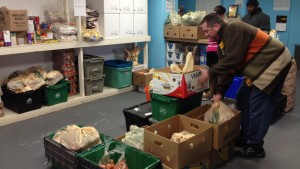A few years ago an outbreak linked to a Denver homeless shelter made it into the barfblog new and notable category. Forty folks who depended on the emergency food were affected by violent foodborne illness symptoms after eating donated turkey. Fourteen ambulances showed up and took those most affected to area hospitals.
Volunteering as a food handler at a mission, shelter or soup kitchen and having a good heart and intentions doesn’t automatically lead to safe meals. An understanding of risks and having systems how to reduce them may.
Around the same time as the Denver outbreak, colleague, friend and STEC CAP collaborator Christine Bruhn created a set of food safety materials for folks volunteering with food in their communities. Ashley Chaifetz, a former graduate student in the department of public policy at UNC-Chapel Hill took Christine’s content foundation and went out to the food pantry community to assess infrastructure and current food safety practices to tailor materials to the audience.
Martha Waggoner of the Associated Press wrote about Ashley’s work this week,
[A] study by researchers at North Carolina State University and the University of North Carolina at Chapel Hill finds that pantry procedures are often informal, although they do a good job in many areas, including provided hand-washing facilities.
“Generally, we found they were doing things pretty well,” said Ben Chapman, senior author of a paper about pantries and food handling published in the Journal of Food Protection. “They were in line with what you see in at commercial entities.”
Safety was likely to be more formal at pantries were associated with a food bank, said Chapman, associate professor of youth, family and consumer sciences at N.C. State.
Chapman and a researcher from UNC-Chapel Hill (Ashley Chaifetz -ben) visited 105 pantries in 12 counties. They then developed protocols for food pantry volunteers, such as a flow chart for when canned food should be tossed.
The researchers learned that some pantries get large cuts of fresh meat that their volunteers must cut, while almost 10 percent were accepting and distributing home-canned items, which can be risky because of the chance of botulism.
“From a hunger standpoint, that’s fantastic,” he said. “Just relying on canned foods and dried foods doesn’t give you a lot of choices … It’s really good for the hunger world, but there’s an increase in safety risks.”
The paper, Evaluating North Carolina Food Pantry Food Safety–Related Operating Procedures, was published online Nov. 1 in the Journal of Food Protection. The work was supported by Agriculture and Food Research Initiative grant 2012-68003-30155 from the U.S. Department of Agriculture’s National Institute of Food and Agriculture.


